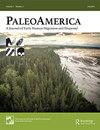Chiquihuite洞穴与美国隐藏的石灰岩工业:对Chatters等人的回应。
IF 1.7
Q1 ANTHROPOLOGY
引用次数: 5
摘要
摘要本文是对Chatters等人(2021。“评估墨西哥Chiquihuite洞穴早期人类占领的说法。”古美洲8,doi:10.1080/20555563.2021.1940441),其中他们对我们关于墨西哥萨卡特卡斯北部Chiquihuit洞穴早于预期的人类存在的说法的合法性提出了大量质疑,主要质疑石器时代组合的人工性质和我们地质环境的完整性。我们回应了他们关注的主要话题,为文物的人类起源辩护。我们还包括10个石器的例子,包括完整的描述和照片,重点是带有使用磨损和故意修改迹象的改性薄片。本文章由计算机程序翻译,如有差异,请以英文原文为准。
Chiquihuite Cave and America’s Hidden Limestone Industries: A Reply to Chatters et al.
ABSTRACT This paper is a reply to Chatters et al. (2021. “Evaluating Claims of Early Human Occupation at Chiquihuite Cave, Mexico.” PaleoAmerica 8, doi:10.1080/20555563.2021.1940441), in which they raise a large number of doubts about the legitimacy of our claims of earlier-than-expected human presence at Chiquihuite Cave, in northern Zacatecas, Mexico, mainly questioning the artificial nature of the lithic assemblage and the integrity of our geological contexts. We respond to their main topics of concern, contributing arguments in defense of the human origin of the artifacts. We also include 10 examples of stone tools, with full descriptions and photographs, focusing on modified flakes that bear indicators of use-wear and intentional modification.
求助全文
通过发布文献求助,成功后即可免费获取论文全文。
去求助
来源期刊

PaleoAmerica
Earth and Planetary Sciences-Paleontology
CiteScore
3.70
自引率
0.00%
发文量
15
期刊介绍:
PaleoAmerica disseminates new research results and ideas about early human dispersal and migrations, with a particular focus on the Americas. It fosters an interdisciplinary dialog between archaeologists, geneticists and other scientists investigating the dispersal of modern humans during the late Pleistocene. The journal has three goals: First and foremost, the journal is a vehicle for the presentation of new research results. Second, it includes editorials on special topics written by leaders in the field. Third, the journal solicits essays covering current debates in the field, the state of research in relevant disciplines, and summaries of new research findings in a particular region, for example Beringia, the Eastern Seaboard or the Southern Cone of South America. Although the journal’s focus is the peopling of the Americas, editorials and research essays also highlight the investigation of early human colonization of empty lands in other areas of the world. As techniques are developing so rapidly, work in other regions can be very relevant to the Americas, so the journal will publish research relating to other regions which has relevance to research on the Americas.
 求助内容:
求助内容: 应助结果提醒方式:
应助结果提醒方式:


